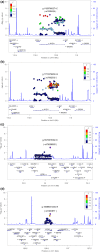Associations of genetic variants in endocytic trafficking of epidermal growth factor receptor super pathway with risk of nonsyndromic cleft lip with or without cleft palate
- PMID: 30411541
- PMCID: PMC6305670
- DOI: 10.1002/mgg3.497
Associations of genetic variants in endocytic trafficking of epidermal growth factor receptor super pathway with risk of nonsyndromic cleft lip with or without cleft palate
Abstract
Background: The genetic etiology of nonsyndromic cleft lip with or without cleft palate (NSCL/P) has not been fully clarified to date. Epidermal growth factor receptor (EGFR) was reportedly involved in its biological establishment and regulation of cell migration during the embryonic stage.
Methods: We selected a super pathway of endocytic trafficking of EGFR and investigated the associations of single-nucleotide polymorphisms (SNPs) in the super pathway with the risk of NSCL/P by analyzing our published genome-wide association study (GWAS) data from 504 NSCL/P individuals and 455 controls. After the false discovery rate (FDR) control, we conducted linkage disequilibrium (LD) analyses and conditional regression analyses to obtain independent lead SNPs. We performed LD analyses between the lead SNPs and the reported SNPs to find novel ones from our study. We annotated the lead SNPs and investigated their mapped genes in silico.
Results: A total of 82 SNPs showed a statistical association with the risk of NSCL/P after FDR control. They contained three reported SNPs which were g.117068049G>A (rs7078160), g.117086783C>G (rs10886040), and g.117101266G>T (rs17095681). Four independent lead SNPs were obtained, including g.116979803 T>C (rs1905539) and g.117037960A>G (rs7902502) at 10q25.3, g.35720163G>C (rs75656820) at 17q12, and g.156864512G>A (rs1800877) at 1q23.1. Three of them were in low LD (r2 < 0.5) with the reported SNPs except g.117037960A>G (rs7902502), so these three were newly identified. Lead SNPs were mapped to three genes: SHTN1, AP2B1, and NTRK1. The three genes were relatively more highly expressed in the human craniofacial region and in the proximal maxillary location during the craniofacial development stage of the embryonic mouse.
Conclusion: Our results suggested that SHTN1, AP2B1, and NTRK1 might be associated with the development of NSCL/P.
Keywords: endocytosis; epidermal growth factor receptor; genome-wide association study; nonsyndromic cleft lip with or without cleft palate; pathway; single-nucleotide polymorphism.
© 2018 The Authors. Molecular Genetics & Genomic Medicine published by Wiley Periodicals, Inc.
Figures




References
-
- Abbott, B. D. , Buckalew, A. R. , DeVito, M. J. , Ross, D. , Bryant, P. L. , & Schmid, J. E. (2003). EGF and TGF‐alpha expression influence the developmental toxicity of TCDD: Dose response and AhR phenotype in EGF, TGF‐alpha, and EGF + TGF‐alpha knockout mice. Toxicological Sciences, 71(1), 84–95. 10.1093/toxsci/71.1.84 - DOI - PubMed
-
- Beaty, T. H. , Murray, J. C. , Marazita, M. L. , Munger, R. G. , Ruczinski, I. , Hetmanski, J. B. , … Scott, A. F. (2010). A genome‐wide association study of cleft lip with and without cleft palate identifies risk variants near MAFB and ABCA4. Nature Genetics, 42(6), 525–529. 10.1038/ng.580 - DOI - PMC - PubMed
Publication types
MeSH terms
Substances
Associated data
- Actions
- Actions
- Actions
LinkOut - more resources
Full Text Sources
Medical
Molecular Biology Databases
Research Materials
Miscellaneous

